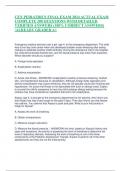CEN PEDIATRICS FINAL EXAM 2024 ACTUAL EXAM
COMPLETE 200 QUESTIONS WITH DETAILED
VERIFIED ANSWERS (100% CORRECT ANSWERS)
/ALREADY GRADED A+
Emergency medical services rush a girl, age 4, to the emergency department. The child
was at her day care center when she developed sudden-onset wheezing after eating
cookies to celebrate another child's birthday. During the ambulance ride to the hospital,
the child demonstrated flushed skin, and her blood pressure was lower than expected.
Which disorder should you suspect?
A. Foreign body aspiration
B. Anaphylactic reaction
C. Asthma exacerbation
D. Acute viral illness - ANSWERAn anaphylactic reaction produces wheezing, flushed
skin, and hypotension because of vasodilation. Although foreign body aspiration and
asthma exacerbation may cause wheezing, they do not typically cause skin flushing and
hypotension. An acute viral illness is not associated with such an abrupt onset. Expect
to counsel the child's caregivers to have the child undergo allergy testing because the
cookies may have contained an ingredient that led to her anaphylaxis.
Alyssa, age 4, is brought to the emergency department by her parents, who inform you
that Alyssa has had a bad cough for the past 5 days. They also inform you that Alyssa
has asthma. You observe that Alyssa is quiet and pale. What is your first priority in
triage for Alyssa?
A. Assess the work of breathing.
B. Obtain a temperature.
C. Measure oxygen saturation.
D. Measure the blood pressure. - ANSWERAt this time, based on Alyssa's history and
signs and symptoms, the priority is assessing the work of breathing to determine her
level of respiratory distress. Assessing the work of breathing is one of the three
components of the Pediatric Assessment Triangle. Expect to perform all of the other
assessments, but they are not the initial priority.
,Which parameter is part of the secondary survey?
A. Work of breathing
B. General appearance
C. Circulation to the skin
D. Vital signs - ANSWERVital signs are an important part of the secondary survey. The
Pediatric Assessment Triangle, which is completed on the child's presentation to the
emergency department, uses three physiologic parameters to evaluate the severity of
illness and injury: general appearance, work of breathing, and circulation to the skin.
f 52 to 92 mm Hg, and weight of 3 kg.
What is the most common cause of status epilepticus in pediatric patients?
A. Trauma
B. Anoxia
C. Febrile illness
D. Infection - ANSWERFebrile illness is by far the most common cause of status
epilepticus in pediatric patients. However, status epilepticus may also be a
manifestation of anoxia, infection, trauma, ingestion, or metabolic disorder.
Which viral illness is potentially life threatening in very young infants?
A. Croup
B. Pertussis
C. Epiglottitis
D. Bronchiolitis - ANSWERBronchiolitis is a viral illness that causes
expiratory obstruction,
air trapping, and
thick, copious mucous,
resulting in varying degrees of respiratory distress.
It can be life threatening in very young infants and in high-risk patients, such as those
who have a congenital heart defect, a chronic lung disease, human immunodeficiency
virus (HIV) infection, or chromosomal abnormalities.
what is Croup - ANSWERa common viral illness of young pediatric patients, but it is
rarely life threatening.
Pertussis and epiglottitis are - ANSWERbacterial infections that are preventable with
immunization.
, Which abnormality should you expect to find in a cold-stressed neonate? -
ANSWERHypoglycemia
Cold stress may precipitate hypoglycemia but does not cause hypercalcemia,
hypocalcemia, or hypokalemia.
Which statement accurately characterizes cardiovascular emergencies in pediatric
patients?
A. Primary rhythm disturbances are common in pediatric patients.
B. Congenital heart disease is the leading cause of heart failure in these patients.
C. Hemorrhage due to trauma is the chief cause of significant volume loss.
D. Anaphylaxis typically causes petechial or purpuric skin lesions. -
ANSWERCongenital heart disease accounts for most of the pediatric patients seen in
the emergency department with heart failure.
In pediatric patients, primary rhythm disturbances are uncommon because rhythm
disturbances usually result from an underlying disorder, such as hypoxia or a metabolic
disturbance.
The chief cause of volume loss is dehydration caused by gastrointestinal disorders.
Patients with septic shock, not anaphylaxis, develop petechiae and purpura.
Magical thinking is characteristic of pediatric patients in which developmental stage?
A. Toddler
B. Preschool
C. School age
D. Adolescent - ANSWERPreschoolers are magical, illogical thinkers and have difficulty
distinguishing fantasy from reality.
The psychosocial development normally associated with toddlers, school-age children,
and adolescents does not include magical thinking.
What condition are pediatric patients at increased risk for because of their shorter necks
and tracheas?
A. Right mainstem intubation
B. Airway compression
C. Airway obstruction
D. Aspiration - ANSWERBecause of their shorter necks and tracheas, pediatric patients
are at increased risk for right mainstem intubation.
A cartilaginous larynx puts the pediatric patient at increased risk for airway compression
with hyperflexion or hyperextension.
A larynx that is more anterior and cephalad increases the risk of aspiration and airway
obstruction.




